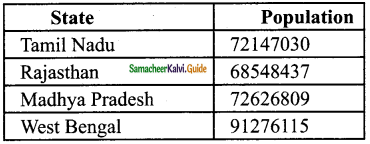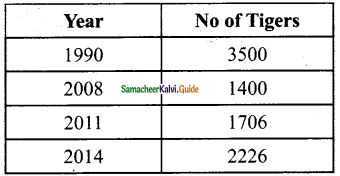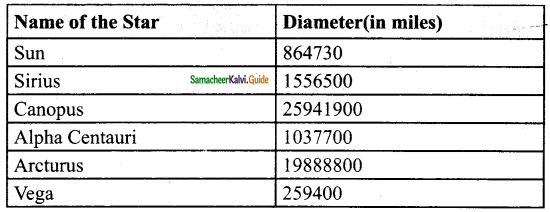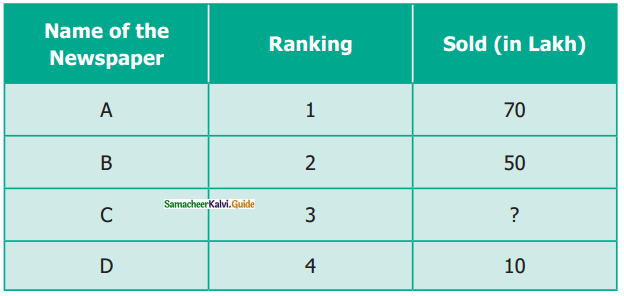Students can download Maths Chapter 2 Measurements Ex 2.1 Questions and Answers, Notes, Samacheer Kalvi 6th Maths Guide Pdf helps you to revise the complete Tamilnadu State Board New Syllabus, helps students complete homework assignments and to score high marks in board exams.
Tamilnadu Samacheer Kalvi 6th Maths Solutions Term 2 Chapter 2 Measurements Ex 2.1
Question 1.
Fill in the blanks.
(i) 250 ml + \(\frac{1}{2}\) ml = _____ l.
(ii) 150 kg 200 g + 55 kg 750 g = ____ kg ____ g.
(iii) 20 l – 1 l 500 ml = ____ l ___ ml
(iv) 450 ml × 5 = ____ l ____ ml.
(v) 50 Kg ÷ 100 g = ______
Solution:
(i) \(\frac{3}{4}\) l
(ii) 205 kg 950 g
(iii) 18 l 500 ml
(iv) 2l 250 ml
(v) 500
![]()
Question 2.
True or False.
(i) Pugazhenthi ate 100 g of nuts which is equal to 0.1 kg.
(ii) Meena bought 250 ml of buttermilk which is equal to 2.5 l.
(iii) Karkuzhali’s bag 1 kg 250 g and Poongkodi’s bag 2 kg 750 g. The total weight of their bags 4 kg.
(iv) Vanmathi bought 4 books each weighing 500 g. Total weight of 4 books is 2 kg.
(v) Gayathri bought 1 kg of birthday cake. She shared 450 g with her friends. The weight of cake remaining is 650 g.
Solution:
(i) True
(ii) False
(iii) True
(iv) True
(v) False
![]()
Question 3.
Convert into indicated units:
(i) 10 l and 50 ml into ml
(ii) 4 km and 300 m into m
(iii) 300 mg into g
Solution:
(i) 10 l and 50 ml
= 10 × 1000 ml + 50 ml
= (10000 + 50)ml
= 10050 ml
(ii) 4 km and 300 m
= 4 × 1000 + 300 m
= (4000 + 300) m
= 4300 m
(iii) 300 mg
= \(\frac{300}{1000}\)g
= 0.3 g
![]()
Question 4.
Convert into higher units:
(i) 13000 mm
(km, m, cm)
Solution:
13000 mm
= \(\frac{13000}{10}\) cm
= 1300 cm
= \(\frac{13000}{1000}\) m = 13000 mm
= 13 m
= \(\frac{13000}{1000000}\) km = 13000 mm
= 0.013 km
(ii) 8257 ml (kl, l)
Solution:
8257 ml
= \(\frac{8257}{1000}\) l
= 8.257 l
= 8257 ml
= \(\frac{8257}{1000000}\) kl
= 0.008257 kl
![]()
Question 5.
Convert into lower units:
(i) 15 km (m, cm, mm)
(ii) 12 kg (g, mg)
Solution:
(i) 15 km = 15 × 1000 m = 15000 m
15 km = 15 × 100000 cm
= 1500000 cm
15 km = 15 × 1000000 mm
= 15000000 mm
(ii) 12 kg (g, mg)
Solution:
12 kg = 12 × 1000 g
= 12000 g
12 kg = 12 × 1000000 mg
= 12000000 mg
Question 6.
Compare and put > or < or = in the following:
(i) 800 g + 150 g ____ 1 kg
(ii) 600 ml + 400 ml ____ 1 l
(iii) 6 m 25 cm ____ 600 cm + 25 cm
(iv) 88 cm ____ 8 m 8 cm
(v) 55 g ____ 550 mg
Solution:
(i) 800 g + 150g < 3kg
(ii) 600 ml + 400 ml = 1 l
(iii) 6 m 25 cm = 600 cm + 25 cm
(iv) 88 cm < 8 m 8 cm
(v) 55 g > 550 mg
![]()
Question 7.
Geetha brought 2 l and 250 ml of water in a bottle. Her friend drank 300 ml from it. How much of water is remaining in the bottle?
Solution:
Quantity of water Geetha brought = 2 l 250 ml
= 2 × 1000 + 250 ml
= 2000 + 250 ml
= 2,250 ml.
Quantity of water her friend drank = 300 ml
Remaining water = 2250 – 300 = 1950 ml. = 1 litre 950 ml.
Remaining water = 1 litre 950 ml.
Question 8.
Thenmozhi’s height is 1.25 m now she grows 5 cm every year. What would be her height after 6 years?
Solution:
Thenmozhi’s present height = 1.25 m
Rate of growth per year = 5 cm
Her growth in 6 years = 5 cm × 6 = 30 cm.
After 6 years her height = 1.25 m + 30 cm
= 1.25 × 100 + 30 cm
= 125 + 30 cm
= 155 cm.
∴ After 6 years Thenmozhi’s height will be 155 cm.
![]()
Question 9.
Priya bought 22\(\frac { 1 }{ 2 }\) kg of onion, Krishna bought 18\(\frac { 3 }{ 4 }\) kg of onion and Sethu bought 9 kg 250 g of onion. What is the total weight of onion did they buy?
Solution:
Priya’s weight = 22 kg 500 g
Krishna’s weight = 18 kg 750 g
Sethu’s weight = 9 kg 250 g
Total weight = 49 kg 1500 g = 49 kg + 1 kg 500 g = 50 kg + 500 g.
Their total weight = 50 kg 500 g.
Question 10.
Maran walks 1.5 km every day to reach the school while Mahizhan walks 1400 m. Who walks more distance and by how much?
Solution:
Distance which Maran walks = 1.5 km = 1.5 × 1000 m = 1500 m
The distance which Mahizhan walks = 1400 m.
Here 1500 > 1400
∴ Difference = 1500 – 1400 = 100 m.
∴ Maran walks more distance = 100 m.
![]()
Question 11.
In a JRC one day camp, 150 gm of rice and 15 ml oil are needed for a student. If there are 40 students to attend the camp how much rice and oil are needed?
Solution:
Rice needed for one student = 150 g
Rice needed for 40 students = 150 g × 40 = 6000 g. = \(\frac{6000}{1000}\) kg = 6 kg.
Oil needed for one student = 15 ml
Oil needed for 40 students = 15 ml × 40 = 600 ml. = \(\frac{600}{1000}\) l = 0.6 l
∴ For the camp 6 kg of rice and 0.6 l of oil needed.
Question 12.
In a school, 200 litres of lemon juice is prepared. If 250 ml lemon juice is given to each student, how many students get the juice?
Solution:
Total lemon juice prepared = 200 l = 200 × 1000 ml = 2,00,000 ml.
∴ Quantity of Lemon juice given to one student = 250 ml.
∴ Number of students can get = \(\frac{2,00,000}{250}\) = 800
∴ 800 students can get the lemon juice.
![]()
Question 13.
How many glasses of the given capacity will fill a 2 litre jug?
(i) 100 ml ___
(ii) 50 ml ____
(iii) 500 ml ____
(iv) 1 l ____
(v) 250 ml ____
Solution:
2 litre = 2 × 1000 ml = 2000 ml.
(i) 100 ml
\(\frac{2000}{100}=20\)
20 glasses of 100 ml.
(ii) 50 ml
\(\frac{2000}{50}=40\)
40 glasses of 50 ml
(iii) 500 ml
\(\frac{2000}{500}=4\)
4 glasses of 500 ml
(iv) 1 l
\(\frac{2 l}{1 l}=2\)
2 glasses of 1 l.
(v) 250 ml
\(\frac{2000}{250}=8\)
8 glasses of 250 ml can fill the jug.
Objective Type Questions
Question 14.
9 m 4 cm is equal to ……..
(i) 94 cm
(ii) 904 cm
(iii) 9.4 cm
(iv) 0.94 cm
Solution:
(ii) 904 cm
![]()
Question 15.
1006 g is equal to ____
(a) 1 kg 6 g
(b) 10 kg 6 g
(c) 100 kg 6 g
(d) 1 kg 600 g
Solution:
(a) 1 kg 6 g
Question 16.
Every day 150 l of water is sprayed in the garden. Water sprayed in a week is ……
(i) 700 l
(ii) 1000 l
(iii) 950 l
(iv) 1050 l
Solution:
(iv) 1050 l
Question 17.
Which is the greatest 0.007 g, 70 mg, 0.07 cg?
(a) 0.07 cg
(b) 0.007 g
(c) 70 mg
(d) all are equal
Solution:
(d) all are equal
![]()
Question 18.
7 km – 4200 m is equal to ……….
(i) 3 km 800 m
(ii) 2 km 800 m
(iii) 3 km 200 m
(iv) 2 km 200 m
Solution:
(ii) 2 km 800 m







